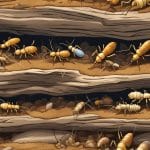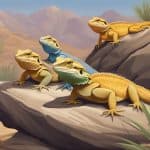Types Of Bugs That Look Like Cockroaches
Cockroaches are one of the most common household pests in the world, and their presence can be a major cause for concern. However, not all insects that look like cockroaches are actually cockroaches. In fact, there are many different types of bugs that are often mistaken for cockroaches, which can make it difficult to identify and treat an infestation.
Common insects mistaken for cockroaches include waterbugs, beetles, crickets, and bed bugs. While these insects may look similar to cockroaches, they have distinct differences in their appearance and behavior that can help you identify them more accurately. It is important to be able to distinguish between these insects and true cockroaches in order to effectively control and prevent infestations.
Identifying features of cockroaches include their flattened, oval-shaped bodies, long antennae, and six legs. They are typically brown or black in color, and can range in size from small to quite large. Cockroaches are also known for their ability to move quickly and their tendency to hide in dark, damp places. By learning to recognize these identifying features, you can better distinguish between cockroaches and other household pests that may look similar.
Key Takeaways
- There are many types of bugs that are commonly mistaken for cockroaches, including waterbugs, beetles, crickets, and bed bugs.
- Identifying features of true cockroaches include their flattened, oval-shaped bodies, long antennae, and six legs.
- Being able to distinguish between cockroaches and other household pests is important for effective control and prevention of infestations.
Common Insects Mistaken for Cockroaches

There are several insects that are commonly mistaken for cockroaches due to their similar appearance. In this section, we will discuss some of the most common insects that are often confused with cockroaches.
Beetles That Look Like Roaches
Beetles are one of the most common insects that are mistaken for cockroaches. They have a similar shape and size, but there are some key differences that can help you tell them apart. For example, beetles have shorter legs and antennae than cockroaches. Additionally, their bodies tend to be harder and more shiny than cockroaches.
Some of the most common beetles that are mistaken for cockroaches include carpet beetles, red flour beetles, and drugstore beetles. These insects are often found in homes and can cause damage to fabrics, furniture, and food products. If you suspect that you have a beetle infestation, it is important to contact a pest control professional to help you identify and eliminate the problem.
Water Bugs and Palmetto Bugs
Water bugs and palmetto bugs are often used to describe cockroaches, but they are actually different species of insects. Water bugs are aquatic insects that are often found near bodies of water, while palmetto bugs are a type of cockroach that is commonly found in the southeastern United States.
Water bugs and palmetto bugs have a similar appearance to cockroaches, but there are some key differences that can help you tell them apart. For example, water bugs have a more streamlined body and longer legs than cockroaches. Palmetto bugs, on the other hand, have a darker color and are larger than most other types of cockroaches.
Crickets and June Bugs
Crickets and June bugs are two other types of insects that are often mistaken for cockroaches. Crickets have a similar shape and size to cockroaches, but they have longer antennae and legs. Additionally, crickets are known for their distinctive chirping sound, which can help you identify them.
June bugs, also known as beetles, have a similar appearance to cockroaches but are typically larger and have a harder exoskeleton. They are often found in gardens and can cause damage to plants and crops.
In conclusion, there are several insects that are commonly mistaken for cockroaches due to their similar appearance. By understanding the key differences between these insects, you can better identify and eliminate pest problems in your home or garden.
Identifying Features of Cockroaches
Cockroaches are a common household pest that can be found all over the world. While they may come in different shapes, sizes, and colors, there are some identifying features that are common to all cockroaches. Here are some of the key characteristics to look for when identifying cockroaches:
- Color: Cockroaches are typically dark brown or black, but some species may have lighter colors or even be green.
- Size: Cockroaches can range in size from just a few millimeters to several centimeters in length.
- Body Shape: Cockroaches have a flat, elongated body with a hard outer shell to protect them. They also have six legs and two antennae.
- Wings: Some species of cockroaches have wings, but not all of them are able to fly.
- Behavior: Cockroaches are nocturnal insects that are most active at night. They tend to hide in dark, moist areas during the day and come out at night to search for food and water.
There are several different species of cockroaches, each with their own unique features. Here are some of the most common types of cockroaches found in households:
- American Cockroach: This species of cockroach is one of the largest and can grow up to 2 inches in length. They are reddish-brown in color and have a distinctive yellowish figure 8 pattern on the back of their head. They are commonly found in warm, moist areas such as basements, bathrooms, and kitchens.
- German Cockroach: German cockroaches are smaller than American cockroaches, typically only growing to about 1/2 inch in length. They are light brown or tan in color and have two dark stripes running down their back. They are commonly found in kitchens and bathrooms.
- Oriental Cockroach: This species of cockroach is also known as a water bug because they prefer damp areas such as basements and crawl spaces. They are shiny black in color and can grow up to 1 1/4 inches in length.
- Smoky Brown Cockroach: These cockroaches are reddish-brown in color and can grow up to 1 1/2 inches in length. They are commonly found in warm, humid areas such as attics, basements, and crawl spaces.
- Brown-banded Cockroach: This species of cockroach is smaller than the German cockroach, typically only growing to about 1/2 inch in length. They are light brown in color and have two light-colored bands across their wings. They are commonly found in warm, dry areas such as bedrooms and living rooms.
By understanding the identifying features of cockroaches and the different species that commonly infest households, you can better identify and address any potential cockroach problems in your home.
Household Pests Similar to Cockroaches
When it comes to household pests, there are a number of insects that can be mistaken for cockroaches. Here are a few to be aware of:
Wood-Boring and Longhorn Beetles
Wood-boring beetles and longhorn beetles are two types of insects that can be mistaken for cockroaches due to their similar appearance. These beetles are typically found in wood and can cause significant damage to furniture, flooring, and other wooden structures in the home.
One way to distinguish between wood-boring beetles and cockroaches is by their antennae. Wood-boring beetles have long, thin antennae that are often longer than their bodies, while cockroaches have shorter, thicker antennae.
Silverfish and Earwigs
Silverfish and earwigs are two other household pests that can be mistaken for cockroaches. Silverfish are small, wingless insects that are typically silver or gray in color. They are often found in damp areas of the home, such as bathrooms and basements.
Earwigs, on the other hand, are dark brown or black insects with long, narrow bodies and pincers on their tails. They are often found in dark, damp areas of the home, such as under sinks or in crawl spaces.
To distinguish between these pests and cockroaches, look for differences in their body shape, size, and color. Silverfish and earwigs are typically smaller and have different body shapes than cockroaches, and may have different coloring or markings as well.
Overall, it is important to be able to distinguish between different types of household pests in order to properly identify and address any infestations. By knowing what to look for and how to differentiate between different insects, homeowners can take the necessary steps to protect their homes and prevent further damage or infestations.
Health Risks and Infestation Signs
Cockroaches can pose several health risks to humans. They are known to carry and spread bacteria, viruses, and parasites, which can cause illnesses such as salmonella, cholera, dysentery, and typhoid fever. In addition, their droppings, saliva, and shed skin can trigger allergies and asthma symptoms in some people.
Infestations of cockroaches can be difficult to detect, especially in the early stages. However, there are some signs that can indicate their presence. These include:
- Foul odor: Cockroaches emit a musty, oily, or mildewy odor that can be quite strong and unpleasant.
- Droppings: Cockroach droppings resemble black pepper or coffee grounds and can be found in areas where they feed or rest.
- Shed skin: Cockroaches shed their skin as they grow, leaving behind empty shells that can be found in infested areas.
- Egg cases: Cockroach egg cases, or oothecae, can also be found in infested areas. They are small, brown, and oval-shaped.
It is important to address cockroach infestations promptly to prevent their spread and minimize the health risks associated with their presence. Professional pest control services can help identify and eliminate cockroach infestations, as well as provide advice on prevention measures such as sealing cracks and crevices, removing food and water sources, and keeping living areas clean and clutter-free.
While bed bugs and termites may also pose health risks and cause infestations, they are not bugs that look like cockroaches. Therefore, they are not relevant to this section.
Prevention and Control of Cockroach Lookalikes
Preventing and controlling cockroach lookalikes is important to avoid infestations and keep your home or business free from pests. Here are some tips for preventing and controlling cockroach lookalikes:
- Keep your home or business clean and clutter-free. This will help eliminate hiding places for pests and reduce the likelihood of an infestation.
- Seal cracks and gaps in walls, floors, and ceilings to prevent pests from entering your home or business.
- Store food in airtight containers to prevent pests from accessing it.
- Keep garbage in sealed containers and dispose of it regularly to prevent pests from feeding on it.
- Use sticky traps or bait stations to monitor and control pests. Be sure to follow the instructions carefully and keep them out of reach of children and pets.
- If you suspect an infestation, contact a pest control professional to identify the pest and develop a treatment plan.
Invasive species, such as the Asian longhorned beetle, can be particularly damaging to trees and other vegetation. If you suspect an invasive species is present, contact your local agriculture department or extension office for guidance on proper identification and control methods.
Pill bugs, also known as sow bugs, are common outdoor pests that can sometimes enter homes. They are not harmful to humans and can be controlled using the same methods as other pests.
Drugstore beetles are small, brown beetles that can infest stored food products. To prevent infestations, store food in airtight containers and inspect it regularly for signs of infestation.
Spiders are not insects, but they can be mistaken for cockroaches due to their similar appearance. While most spiders are harmless and actually beneficial in controlling other pests, some species can be dangerous. If you suspect a spider infestation, contact a pest control professional for identification and treatment.






